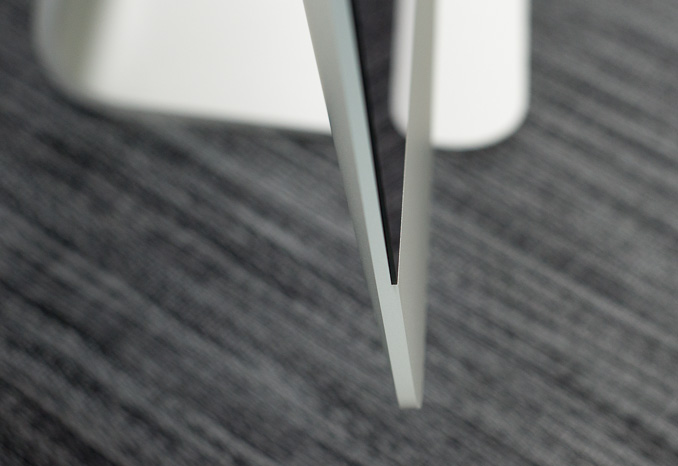21.5-inch iMac (Late 2013) Review: Iris Pro Driving an Accurate Display
by Anand Lal Shimpi on October 7, 2013 3:28 AM ESTFinal Words
Apple continues to have the strongest Mac lineup of its history. While I’m expecting something pretty cool with Broadwell next year, Apple’s Haswell Mac lineup continues to be an evolutionary improvement over the systems that were introduced last year.
The iMac’s industrial design is beautiful. I’m not sure I’m happy with the bezel thickness around the display, but otherwise I’m happy with the way Apple’s 2012 redesign turned out. Particularly with the 21.5-inch model, the compactness of the new iMac is pretty awesome. It’s a lot like the benefits of having a lightweight LCD TV - you only appreciate it when you have to move the thing, but it’s nice to have regardless of how rarely you move it.
Although I didn’t talk about this in the review, the in box wireless peripherals both work well. Combined with the fact that you can get 500Mbps file transfers over 802.11ac (over short distances, with Mavericks), you can really use the iMac with only a single cable and be pretty happy. Toss in Apple’s new 802.11ac Airport Extreme and you’ll have great wireless range as well.
The iMac’s out of box display experience is nothing short of incredible. Imaging professionals in dire need of color accuracy can walk into an Apple store, walk out with the entry-level iMac and have a remarkable experience. I’d love to see a higher resolution panel, but 4K panel pricing isn’t quite low enough yet (not to mention the possibility of Apple wanting to go 5K on its 27-inch display).
I wouldn’t touch either of the iMacs in their default configuration. Thankfully the upgrade to Fusion Drive or an SSD starts at $200, and is a must have. Fusion Drive remains the only solid state hybrid solution I’d touch. If you need a single volume, it’s absolutely the way to go.
CPU performance of the entry-level iMac really is very good. Power users can stand to go for one of the higher-end configurations, particularly if you’re running heavily threaded workloads. Lighter users should enjoy really good single threaded performance out of the base configuration however.
The entry-level iMac offers better integrated graphics performance than we’ve ever seen before, but true gamers will want to spring for a discrete GPU. Iris Pro under OS X (non-gaming) works well and I couldn’t really tell that I wasn’t using discrete graphics.
Thermals aren’t a concern with the base 21.5-inch iMac. The Core i5-4570R had no issues turbo-ing up to 3.0/3.1GHz on a regular basis, and the system fan never ramped up beyond 1400RPM during my testing. Overall the new 21.5-inch iMac is a very compact, cool and quiet machine. The 21.5-inch model in particular is an easy recommendation for anyone looking to get into a Mac desktop. Just make sure to order it with a Fusion Drive or SSD.












127 Comments
View All Comments
g1011999 - Monday, October 7, 2013 - link
Finally. I check anandtech several times recently for Iris Pro based iMac 21" review.malcolmcraft - Thursday, October 9, 2014 - link
It's nice, I agree. But for a full-size work station I'd not recommend Mac. /Malcolm from http://www.consumertop.com/best-desktop-guide/Shivansps - Monday, October 7, 2013 - link
I suspecting that the big loss in performance on high details compared to 750M may be related to L4 eDRAM running short than driver issue, as AA, Intel never had good performance with filters, they support hardware x2 AA yet?tipoo - Monday, October 7, 2013 - link
Yeah, doesn't AA hammer bandwidth? The eDRAM helps performance, but it's still quite low compared to what the other cards are paired with, even in best case scenarios.IntelUser2000 - Tuesday, November 12, 2013 - link
I don't think its just that. Compared to the competition like the Trinity's iGPU and the GT 650M, the texture fill rate is rather low. That impacts performance not only in texture bound scenarios with settings cranked up but anti-aliasing as well. The fillrate of the top of the line Iris Pro 5200 is about equal to Trinity while the version in the iMac would fall short. The GT 650M is 40% better than the top of the line Iris Pro and over 55% better than iMac version.There's also something to be desired about Intel's AA implementation. Hopefully Broadwell improves on this.
IanCutress - Monday, October 7, 2013 - link
Interestingly we see Crystalwell not have any effect on CPU benchmarks, although we can probe latency as seen before.willis936 - Monday, October 7, 2013 - link
This seems counter intuitive. It's acting as a CPU+GPU shared cache correct? Intel architectures are relatively cache bandwidth starved and you'd think that 128MB of L4 would help keep the lower levels filled.Flunk - Monday, October 7, 2013 - link
Perhaps it means that the assumption that Intel architectures are relatively cache bandwidth starved is faulty.name99 - Monday, October 7, 2013 - link
Or that the working set of most benchmarks (if not most apps) is captured with a 4 or 6MB cache?Caching's basically irrelevant for data that is streamed through.
tipoo - Thursday, October 10, 2013 - link
The L4 is pretty low bandwidth for a cache though.